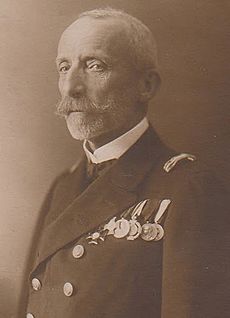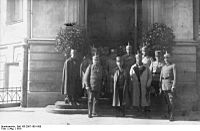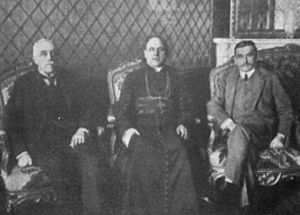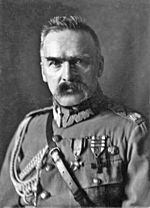Kingdom of Poland (1917–1918) facts for kids
Quick facts for kids
Kingdom of Poland
|
|||||||||||||
|---|---|---|---|---|---|---|---|---|---|---|---|---|---|
| 1917–1918 | |||||||||||||
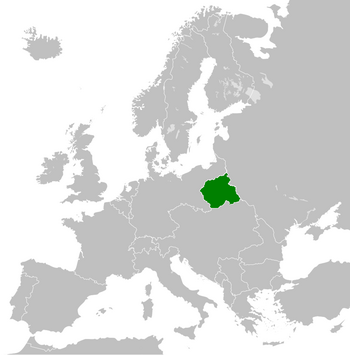 |
|||||||||||||
| Status | Austro-German puppet state | ||||||||||||
| Capital | Warsaw | ||||||||||||
| Common languages | |||||||||||||
| Demonym(s) | Polish, Pole | ||||||||||||
| Government | Unitary constitutional monarchy under a directorial regency | ||||||||||||
| King | |||||||||||||
|
• 1917–1918
|
Vacant | ||||||||||||
| Head of State | |||||||||||||
|
• 1917
|
State Councila | ||||||||||||
|
• 1917–1918
|
Regency Councila | ||||||||||||
| Prime Minister | |||||||||||||
|
• 1917–1918
|
Jan Kucharzewski | ||||||||||||
|
• 1918
|
Antoni Ponikowski | ||||||||||||
|
• 1918
|
Jan Kanty Steczkowski | ||||||||||||
|
• 1918
|
Józef Świeżyński | ||||||||||||
|
• 1918
|
Władysław Wróblewski | ||||||||||||
| Historical era | World War I | ||||||||||||
|
• Proclamation
|
5 November 1916 | ||||||||||||
|
• Established
|
14 January 1917 | ||||||||||||
| 3 March 1918 | |||||||||||||
| 11 November 1918 | |||||||||||||
| Currency |
|
||||||||||||
|
|||||||||||||
|
|||||||||||||
The Kingdom of Poland (also known as the Regency Kingdom of Poland) was a country that existed for a short time during World War I. It was created by the German Empire and Austria-Hungary on November 5, 1916. This new kingdom was set up in parts of Poland that used to be controlled by Russia, known as Congress Poland.
Even though it was controlled by Germany and Austria-Hungary at first, this kingdom played a very important role. After World War I ended, it helped Poland become an independent country again. This new independent country was called the Second Polish Republic, which officially started on November 11, 1918.
Contents
Why Was the Kingdom of Poland Created?
After Poland had been divided up by other countries for about 100 years, Germany decided to bring it back. They wanted to create a new Polish state to help them control the lands they had taken. They also hoped it would act as a barrier to prevent future wars with Russia.
German leaders spread messages saying their soldiers were coming to free Poland from Russia. However, Germany also had secret plans to take about 30,000 square kilometers of Polish land. They even planned to move up to 3 million Poles and Jews out of these areas to make room for German settlers.
Early Ideas for Poland's Future
Germany's Plans for Poland
When World War I started in 1914, Germany wanted to protect its eastern border from the Russian army. The German leader, Theobald von Bethmann Hollweg, decided to take a strip of land from Poland. This area became known as the Polish Border Strip. Germany planned to move the Polish people out of this strip and settle Germans there instead. The Poles would be moved to a new Polish state further east.
German Emperor Wilhelm II wanted to create a Polish state that would depend on Germany. A German prince would rule this new Kingdom of Poland. Germany would control its army, transportation, and economy.
Hans Hartwig von Beseler, the German Governor-General in charge of Polish areas, suggested creating an independent Polish state. However, General Erich Ludendorff, who was in charge of Germany's operations in Eastern Europe, wanted Germany, Lithuania, and Austria-Hungary to take large parts of Poland for themselves.
Many German thinkers believed that Germany should create an independent Polish state. They thought that if Germany tried to take too much Polish land, the Polish people would resist strongly. They felt it was better to have an independent Poland that was still under German protection.
Germany wanted to change Poland's borders to gain more land for itself. By the end of 1916, Germany aimed to take almost 30,000 square kilometers of Polish territory. Germans would settle these lands, and Polish and Jewish people would be moved out.
Germany also planned to control Poland's economy. They wanted to manage the railway system, shipping on the Vistula river, and industrial areas.
Different German royal families wanted their princes to become the new King of Poland. The royal families of Saxony, Württemberg, and Bavaria all had candidates.
Austria-Hungary's Plans for Poland
Austria-Hungary also had ideas for Poland. One idea was the "Austro-Polish Solution." This plan would make the Austrian Emperor also the King of Poland. However, some people in Austria-Hungary worried that this would create too many Slavic people in their empire.
Other ideas included dividing Poland between Germany and Austria-Hungary. Or, creating a new state from Lithuania, Belarus, and parts of Poland, similar to the old Polish-Lithuanian Commonwealth.
Archduke Charles Stephen of Austria and his son, Charles Albert, were considered as candidates for the Polish throne. They lived in a Polish town and spoke Polish fluently.
By early 1916, the "Austro-Polish Solution" became less likely. Germany wanted to keep control over Poland's economy, resources, and army, even if an Austrian prince became king.

During the first year of the war, German and Austrian troops quickly took over the Russian part of Poland. In 1915, they divided the land into two parts. A German Governor General ruled from Warsaw, and an Austrian Governor General ruled from Lublin. During this time, Poles faced forced labor and their food and property were taken.
Creating the Polish State
The Promise of a Polish State
After some military setbacks, German and Austrian leaders changed their minds about Poland. They decided to promise the creation of a Polish state. They hoped that a new Polish army could help them in the war. They agreed that Germany would control Poland's economy, resources, and army.
On November 5, 1916, Governor von Beseler in Warsaw announced that a Polish state would be created. For the first time since 1831, Polish flags were displayed at the Royal Castle in Warsaw. The Austrian Governor-General Kuk made a similar announcement in Lublin.
Polish Leaders and Councils
Provisional Council of State
On January 14, 1917, a group called the Provisional Council of State was formed. This was a temporary government with members chosen by German and Austrian authorities. They wanted a king to rule Poland and supported creating a Polish army. They also wanted Poland to expand its borders to the east.
The Council gained some control over education, law courts, and public information. However, students were not happy with how little power the Council had and went on strike.
The Regency Council
Later, a new provisional government called the Regency Council was set up. It started on October 15, 1917. The Council had three members: Aleksander Kakowski (the Archbishop of Warsaw), Prince Zdzisław Lubomirski (who had been mayor of Warsaw), and Józef Ostrowski (a wealthy landowner).
The Council was officially installed on October 15, the anniversary of Tadeusz Kościuszko's death. On November 26, they appointed Jan Kucharzewski as Prime Minister. However, German authorities still held most of the power.
In August 1918, Achille Ratti came to Warsaw to help the Catholic Church adapt to the new political situation. He later became Pope Pius XI in 1922.
Polish Army and the Oath Crisis
Meanwhile, U.S. President Woodrow Wilson announced that he supported a united and independent Poland. This, along with the fall of the Russian Emperor, strengthened Poles who wanted to be neutral or support the Triple Entente (Britain, France, Russia).
The Council of State wanted to create a Polish army. However, the relationship between Germany and Austria-Hungary and the Polish legions became difficult. The new army's oath, which mentioned an unspecified "future king" and emphasized alliance with Germany and Austria, caused a problem. Many soldiers refused to take the oath. This led to a "political crisis."
As a result, Józef Piłsudski, a key Polish leader, was arrested and held in Germany. The remaining Polish legions were sent to the Eastern front. After the oath crisis, very few people joined the Polish army.
Poland's Borders
The Central Powers did not clearly state Poland's future borders in their 1916 announcement.
Western and Northern Borders
Germany wanted to take a "Polish Border Strip" in the west. This plan was supported by some Germans living in Poland. General von Beseler, however, disagreed with this plan.
In July, General Ludendorff suggested taking an even larger "border strip" of 20,000 square kilometers. Emperor Charles of Austria opposed Germany's plans to take Polish land.
Eastern and Southern Borders
Ludendorff agreed to let Wilno (now Vilnius) and possibly Minsk be part of Poland. But this did not satisfy Poles, who felt Wilno should naturally be Polish. Germany also wanted to create smaller states east of Poland, which further angered Poles.
With German support, Lithuania declared its independence on December 11. Poles were upset because they saw Poland and Lithuania as historically united. They also considered Wilno, the proposed new Lithuanian capital, to be a Polish city.
Austrian politicians also considered giving only western Galicia to Poland. They wanted to create a Ukrainian state from East Galicia and Volhynia. This led to a secret agreement between the Central Powers and Ukraine in February 1918. This agreement gave the province of Chełm (which was part of Poland) to Ukraine. Many Poles saw this as a "Fourth partition of Poland." This caused a general strike in Warsaw and the resignation of the Polish government.
End of the Kingdom and Birth of the Republic
After Germany's attacks on the Western front failed in 1918, General Ludendorff suggested seeking peace. He based this on U.S. President Wilson's Fourteen Points, which called for an "independent Polish state" with "free access to the sea."
On October 3, the new German Chancellor, Prince Maximilian of Baden, announced Germany's acceptance of Wilson's plan. Three days later, the Regency Council in Warsaw also agreed to Wilson's proposals for creating a Polish state.
On October 6, General von Beseler handed over control to Polish civil servants. The Regency Council declared Poland's independence on October 7, 1918. They then put the Świeżyński government in charge.
However, another Polish government was formed in Lublin on November 6. This government, led by Ignacy Daszyński, called itself the "Polish People's Republic."
Meanwhile, the Regency Council asked for Józef Piłsudski to be released from German custody. He returned to Warsaw on November 10. The next day, Germany signed the armistice, ending World War I. German troops in Warsaw were disarmed.
On the same day, the Daszyński government gave all its power to Piłsudski and resigned. The Regency Council also transferred its military authority to him. On November 14, the Regency Council gave all its remaining power to Piłsudski and dissolved itself.
On November 16, 1918, Piłsudski sent a telegram to world leaders, announcing the establishment of an independent Polish state, called the Polish Republic.
The transition to a republican government was completed on November 22, 1918. Piłsudski became the interim chief of state. This marked the official end of the Kingdom of Poland and the beginning of the Second Polish Republic.
See also
 In Spanish: Regencia de Polonia para niños
In Spanish: Regencia de Polonia para niños
- History of Poland (1795–1918)
- Diplomatic history of World War I




